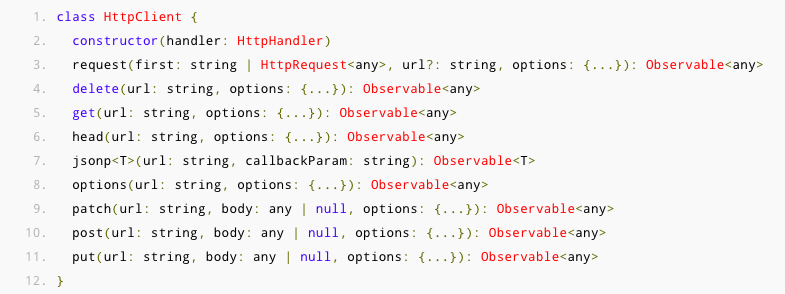官方文件:https://angular.io/api/common/http/HttpClientModule
下面是一個簡單的使用範例,假使我們要讀取這樣格式的JSON資料:
{
"results": [
"Item 1",
"Item 2",
]
}
@Component(...)
export class MyComponent implements OnInit {
results: string[];
// Inject HttpClient into your component or service.
constructor(private http: HttpClient) {}
ngOnInit(): void {
// Make the HTTP request:
this.http.get('/api/items').subscribe(data => {
// Read the result field from the JSON response.
this.results = data['results'];
});
}
}
this.results即為一個含有["item1","item2"]的陣列
首先先建立一個要回傳的物件介面
interface ItemsResponse {
results: string[];
}
在get後面設定要回傳的資料的格式
http.get<ItemsResponse>('/api/items').subscribe(data => {
// data is now an instance of type ItemsResponse, so you can do this:
this.results = data.results;
});
很多時候我們也會需要Http header的資料,而不光是回傳的body,這時候可以更改observe的值為response
http
.get<MyJsonData>('/data.json', {observe: 'response'})
.subscribe(resp => {
// Here, resp is of type HttpResponse<MyJsonData>.
// You can inspect its headers:
console.log(resp.headers.get('X-Custom-Header'));
// And access the body directly, which is typed as MyJsonData as requested.
console.log(resp.body.someField);
});
可以在.subscribe()下面增加err函數來處理HTTP錯誤的狀況
http
.get<ItemsResponse>('/api/items')
.subscribe(
// Successful responses call the first callback.
data => {...},
// Errors will call this callback instead:
err => {
console.log('Something went wrong!');
}
);
err這個含數可以有傳入更詳細的HTTP錯誤訊息物件HttpErrorResponse
http
.get<ItemsResponse>('/api/items')
.subscribe(
data => {...},
(err: HttpErrorResponse) => {
if (err.error instanceof Error) {
// A client-side or network error occurred. Handle it accordingly.
console.log('An error occurred:', err.error.message);
} else {
// The backend returned an unsuccessful response code.
// The response body may contain clues as to what went wrong,
console.log(`Backend returned code ${err.status}, body was: ${err.error}`);
}
}
);
RxJS有一個有用的運算符.retry(),可以在遇到錯誤時自動重新嘗試,使用範例如下: 先導入需要的類別
import 'rxjs/add/operator/retry';
使用的方式就是直接.retry()並傳入重試次數
http
.get<ItemsResponse>('/api/items')
// Retry this request up to 3 times.
.retry(3)
// Any errors after the 3rd retry will fall through to the app.
.subscribe(...);
傳入responseType可以設定預期會接收到的資料格式,angular預設值是json,如果是其他格式則需要設定這個欄位。 可接受的項目有『arraybuffer』、『blob』、『json』、『text』。 下面是使用方式:
http
.get('/textfile.txt', {responseType: 'text'})
// The Observable returned by get() is of type Observable<string>
// because a text response was specified. There's no need to pass
// a <string> type parameter to get().
.subscribe(data => console.log(data));
下面是發送POST請求的範例:
const body = {name: 'Brad'};
http
.post('/api/developers/add', body)
// See below - subscribe() is still necessary when using post().
.subscribe(...);
所有rxjs的動作都會在有人subscribe後才會呼叫,因此如果忽略subscribe(),http將不會做任何動作。
下面為一個簡單範例:
const req = http.post('/api/items/add', body);
// 0 requests made - .subscribe() not called.
req.subscribe();
// 1 request made.
req.subscribe();
// 2 requests made.
http
.post('/api/items/add', body, {
headers: new HttpHeaders().set('Authorization', 'my-auth-token'),
})
.subscribe();
該HttpHeaders的內容是不變的,每次set()時會返回一個新的實體,並套用所設定的更改。
如果想要發送請求至/api/items/add?id=3,可以用以下的寫法
http
.post('/api/items/add', body, {
params: new HttpParams().set('id', '3'),
})
.subscribe();

可以講一下 header 怎麼加 XD
XDDD 太感謝你了!我發現我本來有寫,但手殘被我刪掉了,剛剛從我的歷史紀錄裡把文章救回來XDD
大大也太強,我漏寫了什麼一下就看出來了!
XDD